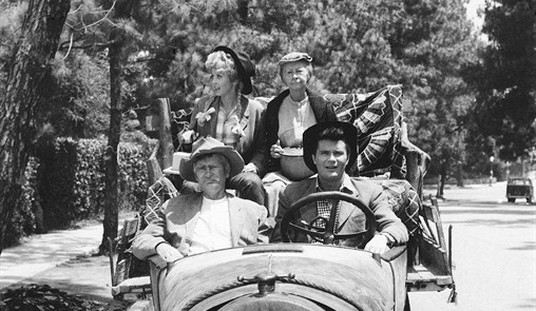Earlier, I posted some excerpts from my new book, The Devil’s Pleasure Palace, currently the top bestseller on the Amazon Philosophy/Criticism list. They largely concerned the origins of Critical Theory and the Marxists who promulgated the culturally destructive assault on western, Judeo-Christian morals and civilization. Conceived in the aftermath of World War I (the greatest debacle in western history), Critical Theory sought to finish the job the satanic slaughter in the trenches had started, and it did so by going after every important pillar of our shared society.
Foremost among those pillars was sex (not “gender”), sexual mores, and the family. If they could destroy the nuclear family, especially under the guise of “sexual freedom” or, even better, “liberation,” they were a long way toward their goal of a post-Christian, post-Western world. Far from being the “feminists” their unholy offspring pretend to be, both the original Frankfurt School critical theorists were instead profoundly, misogynistically anti-female. Discussing the role of the Woman in just about any work of narrative art you can mention, I write:
And who represents the saving power of divine grace? Almost invariably, the woman, whose own self-sacrifice rescues and transfigures the flawed male hero. In Goethe’s famous words from the second part of Faust: “Das Ewig-Weibliche zieht uns hinan,” or, “the Eternal Feminine draws us onward.” The Eternal Feminine, a sexually anti-egalitarian concept that feminists of both sexes today would regard as laughable, is one of the organizing principles of the cosmos, and a crucial factor in the hero’s journey. Even the pansexuality of today, try though it might, cannot replace this naturally primal force: the union of opposites into a harmonious, generative whole…
Faust, so very German, adumbrates modern man: born in the nineteenth century, wreaking havoc in the twentieth, and still battling against both God and the Devil in the twenty-first, often while denying the existence of both. He is the essence of the daemonic, if not quite the satanic. After all, in Goethe’s telling, Faust is ultimately saved, in part by Gretchen’s sacrifice—saved, that is, by the Eternal Feminine, the sexual life force greater than the power of Hell, which pulls men ever onward and closer to the Godhead—and also by God’s infinite grace, which can even overcome a bargain with the Devil, if man only strives hard enough.
What would the Unholy Left do without illusion? It is the cornerstone of their philosophical and governing philosophy, a desperate desire to look at basic facts and plain meanings and see otherwise, to see, in fact, the very opposite. From this standpoint, nothing is ever what it seems (unless it comports with quotidian leftist dogma), and everything is subject to challenge. At the same time, the Left’s fondness for complexity over simplicity betrays its affection for obfuscation and misdirection. As has often been remarked, the leftist program dares not show its true face in an American election, because it would be overwhelmingly rejected (even today, after a century of constant proselytism from its redoubts in academia and the media). But in an age when credentialism is disguised as supreme, practically Faustian knowledge, and when minutiae are elevated to the status of timeless universal principles (even as the existence of such principles is otherwise denied), Leftism masquerades as sophistication and expertise. But the mask conceals only intellectual juvenile delinquency gussied up in Hegelian drag. The coat might be too small and the shoes too big, but if you don’t look too closely—as in Billy Wilder’s Some Like It Hot—the illusion might pass for reality.
So let’s cut to the chase:
The assault on the citadels of Western culture had many fronts, but foremost among them was sex—the most powerful engine in human existence, the one that brings us closest to the Godhead, a force of such overwhelming power that it can change the courses of our lives, bringing death or transcendence in its wake. Children are its primary issue, but also transformative insight, bravery, courage, altruism, self-sacrifice; great works of art are born from the union, lives sacrificed and won, everything ventured, worlds gained.
So no wonder the relationship between the sexes and the hard-won morality attending such congress was one of the focal points of the attack by the Frankfurt School and their fellow travelers in politics, academe, and the media. The “transgressive” assault on Western culture had to start somewhere, and it started with the idea of the nuclear family.
The first step was to mock it (in the 1960s and ’70s, the idealized “Father Knows Best” and “Leave It to Beaver” worlds of the pre-hippie era came in for particular scorn), then to accuse it of various crimes against humanity (particularly the newfound charge of “patriarchy”), then to illustrate that there were “really” other sorts of families, just as good, just as loving, just as valid at the traditional two-parent opposite-sex nest. Finally, the nuclear family was simply dispensed with altogether, as behavior considered acceptable in the underclass, where sexual license had always just barely been suppressed, percolated up into the higher culture. The morals of those with nothing to lose and everything to gain from a dysfunctional social-welfare system bubbled upward from the black and white underclasses into the middle classes, who had been induced to feel guilty on behalf of the “underprivileged.” And those considered “marginal” or “disadvantaged” longer bore any responsibility for their destructive personal choices and behavior. It is no accident that the new social acceptance of out-of-wedlock pregnancies coincided with the rise of both bastardy and the abortion culture, the growing demand for contraception, and, later on, gay rights. Once Pandora’s Box was opened, all sort of things flew out, some of them at first seemingly contradictory, but all related by the very fact of their confinement in the Box. The Box had stayed closed for a reason, but under pressure from Critical Theory, it had to be opened.
The lead crackpot on the sexual revolution front was Wilhelm Reich. Charlatan, mountebank, horn dog, jailbird — Reich had it all. Combining two of the worst ideas of the 20th century — Critical Theory and Freudian psychiatry — Reich carved out a unique place for himself in the devil’s pleasure palace:
In 1931, two strains of twentieth-century thought combined forces at the Institut für Sozialforschung: Freudian psychiatry and social Marxism. Among the shrinks was Wilhelm Reich, who had fled the Nazis and settled in America where he (to quote the website Marxists.org) “developed his own doctrine of sexual liberalism as an antidote to political conformism and social psychosis.” After Marcuse, no other member of the Frankfurt School had such a negative impact on the culture.
Too crazy even for the Freudians and the social Marxists, all of Reich’s work after 1932 (he died in 1957) was initially self-published. Sex-mad in a way that embarrassed even his Freudian cronies and amoral Marxist colleagues (he coined the term “the sexual revolution”), Reich believed that the problems of economic Marxism were caused by sexual frustration, which hindered the political consciousness of the proletariat. He stripped his patients nude, the better to break down their “muscular armor,” and pursued “vegetotherapy” while chasing the perfect orgasm. The Function of the Orgasm is his most famous work. Reich also invented something he called “orgone,” a kind of sexual “cosmic energy,” and built “orgone accumulators” in which to contain it. The U.S. Food and Drug Administration called him “a fraud of the first magnitude.” He died, intermittently psychotic, in the federal penitentiary in Lewisburg, Pennsylvania, a prison that had once held Al Capone.
Reich defended the scientific legitimacy of his crackpot ideas (Woody Allen parodied the “orgone energy accumulator” as the “orgasmatron” in Sleeper) in the preface to the second edition of The Function of the Orgasm with this classic example of Teutonic bafflegab:
Sex-economy is a natural-scientific discipline. It is not ashamed of the subject of sexuality, and it rejects as its representative everyone who has not overcome the inculcated social fear of sexual defamation. The term “vegetotherapy,” used to describe the sex-economic therapeutic technique, is actually a concession to the squeamishness of the world in sexual matters. “Orgasmotherapy” would have been a much better, indeed more correct term, for this medical technique: That is precisely what vegetotherapy basically is. It had to be taken into consideration, however, that this term would have entailed too great a strain on the young sex-economists in their practice. Well, it can’t be helped. Speak of the core of their natural longings and religious feelings and people will either laugh derisively or snicker sordidly.
Summarizing something every teenage boy knows after his first encounter with porn, Reich goes on to illustrate the “scientific” principles behind his revolutionary new theory: “The orgasm formula which directs sex-economic research is as follows: MECHANICAL TENSION → BIOELECTRIC CHARGE → BIOELECTRIC DISCHARGE → MECHANICAL RELAXATION.… The immediate cause of many devastating diseases can be traced to the fact that man is the sole species which does not fulfill the natural law of sexuality.”
“If it feels good, do it” — now you know where that came from. Hugh Hefner and the “Playboy philosophy” are unthinkable without Reich, and his theories were accepted by such intellectual luminaries as Saul Bellow and Norman Mailer.
What, after all, did “sexual liberation” accomplish? What positive good did it achieve? Other than providing men with greater, easier access to women, how did it improve anyone’s life? It promised us liberation from “sexual repression” (what teenaged boys used to call, sniggeringly, DSB,), freedom from an old and tired sexual morality. It promised to tear down the Chesterton’s Fence that stood between our libidos and our responsibilities. It is easy to see why it was popular, since it partly leveled the sexual playing field for beta males, whose chances of sexual “conquest” vastly improved once “conquest” was taken out of the equation and a woman’s natural resistance to indiscriminate sex (or less discriminating sex) was broken down. In the guise of cooperative pleasure, it erected a new egalitarianism between the sexes, told women that their sex drives and their sexual responsibilities were exactly the same as a man’s. (It’s a mystery why no feminist of the time complained that, in effect, the new doctrine still portrayed women as lesser creatures who needed to raise—or lower—their sexual sights to the level of a man’s.) The newfound “liberation” led to a rapid increase in abortion, sexually transmitted diseases, HIV and AIDS, and illegitimate children. Finally, wearing the masque of “progress,” it returned Westerners to primitive levels of sexuality, kicking out the moral underpinnings of the culture (even if the morals were often observed more in the breach than in practice). Who knew that the slogan “Every man a stud, every woman a slut” could be a winner? It is not for humanity to defeat Sin, but to be wary and canny in our interaction with it. And, in any case, the Ewig-Weibliche will never stoop to whoredom.
Healthy sexuality is one of the culture’s greatest forces; after all, in Milton’s Paradise Lost, the first thing Adam and Eve do after the Fall is make love. Corrupted, however, it turns destructive, meaningless, satanic. Ask yourself — is American society better off today than it was before the “sexual revolution”? And yet, it all seemed so sweetly, purringly seductive…
“On the Unholy Left, there is no idea too stupid to try, no institution unworthy of attack, no theory not worth implementing without care for its results, no matter what the practical cost. Intentions are everything, results are nothing. Results are an illusion; theory is what counts, because theory can be debated endlessly within the safe harbors of academe. The key is to examine what those intentions really are.”
Those intentions will be the subject of our third and final installment.












Join the conversation as a VIP Member